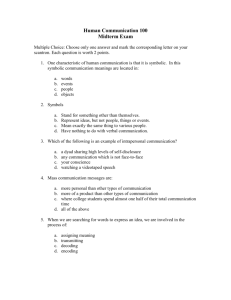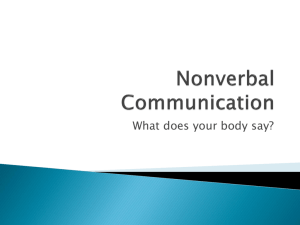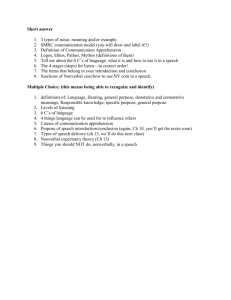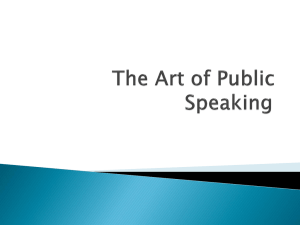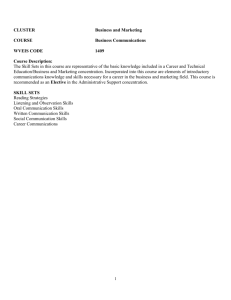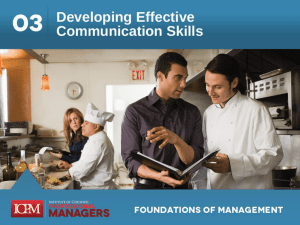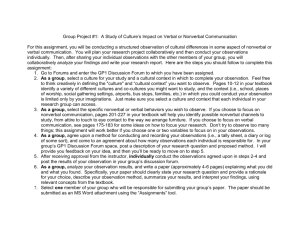Outlining Your Speech
advertisement
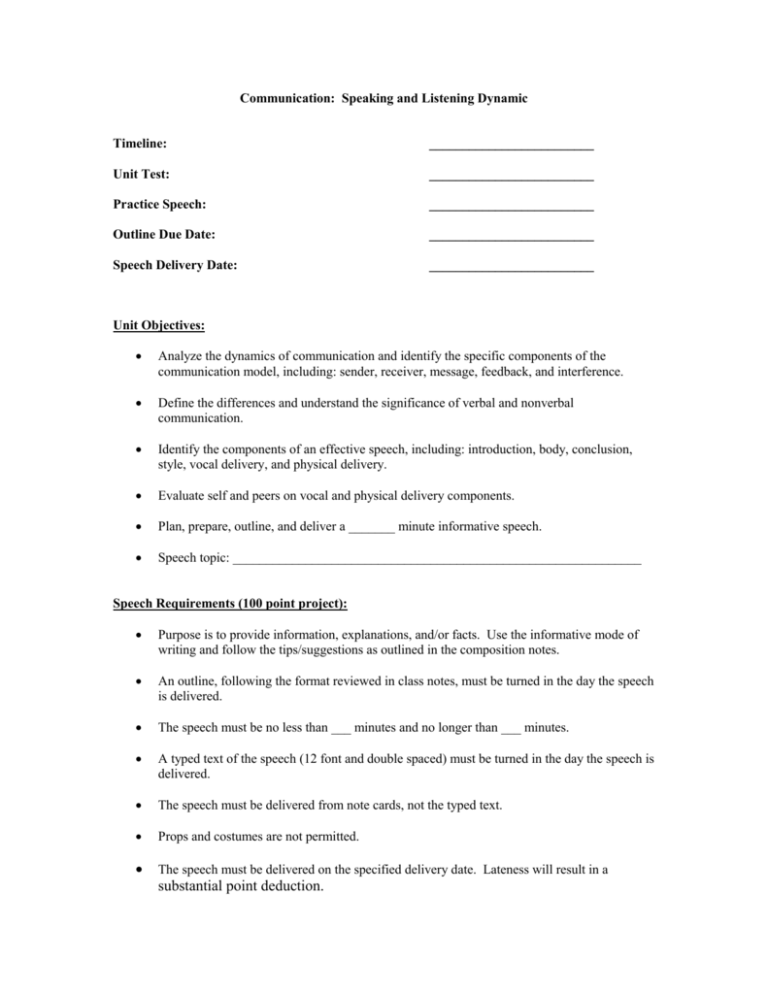
Communication: Speaking and Listening Dynamic Timeline: _________________________ Unit Test: _________________________ Practice Speech: _________________________ Outline Due Date: _________________________ Speech Delivery Date: _________________________ Unit Objectives: Analyze the dynamics of communication and identify the specific components of the communication model, including: sender, receiver, message, feedback, and interference. Define the differences and understand the significance of verbal and nonverbal communication. Identify the components of an effective speech, including: introduction, body, conclusion, style, vocal delivery, and physical delivery. Evaluate self and peers on vocal and physical delivery components. Plan, prepare, outline, and deliver a _______ minute informative speech. Speech topic: ______________________________________________________________ Speech Requirements (100 point project): Purpose is to provide information, explanations, and/or facts. Use the informative mode of writing and follow the tips/suggestions as outlined in the composition notes. An outline, following the format reviewed in class notes, must be turned in the day the speech is delivered. The speech must be no less than ___ minutes and no longer than ___ minutes. A typed text of the speech (12 font and double spaced) must be turned in the day the speech is delivered. The speech must be delivered from note cards, not the typed text. Props and costumes are not permitted. The speech must be delivered on the specified delivery date. Lateness will result in a substantial point deduction. Communication Model – Notes Definition of COMMUNICATION: Dynamic of speaking and listening Communication Model: I N T E R F E R E N C E SENDER VERBAL MESSAGE NONVERBAL MESSAGE VERBAL FEEDBACK NONVERBAL FEEDBACK 1. Sender: 2. Message: What is being communicated, conveyed I N T E R F E R E N C E RECEIVER Speaker a. Verbal – words being said b. Nonverbal – Unspoken signals, body language 3. Receiver: Listener 4. Feedback: Lets the speaker know that the listener heard the “intended” message a. Verbal b. Nonverbal 5. Interference: Anything which disrupts the communication process ( ex. background noises, interruptions, daydreaming, perceptions) Examples of nonverbal communication: posture, eye contact, facial expressions, distance of body, gestures, tone/inflections *** 90 - 95% of all communication is nonverbal! Preparing to Speak I. Communication Apprehension A. Defined as: Fear of speaking in public; stage fright B. Prevention tips II. 1. *** Prepare a strong speech that you can be very proud of 2. *** Practice your speech over and over again (videotape, mirror, live audience) 3. Acknowledge your fears and realize that the fears can be "managed" 4. Relate the subject of the speech to the audience (Make the audience understand the benefits to listening to your speech) 5. Project confidence, even if it is only an "act" 6. Start strong (introduction) and end strong (conclusion) 7. Deep breathing 8. Lots of water, avoid caffeine; chapstick (will help with "dry mouth") 9. Think positively, guided imagery 10. Use note cards (only necessary references; highlight pauses, words to emphasize, gestures) Supporting Materials (Think of how EACH item below can be used in your assigned speech; Make a note of any idea that occurs to you during class that you may wish to later include in your speech) A. Factual 1. Facts – Units of information that can be verified by independent observers (can be proven true) 2. Definitions a. Denotative - literal, dictionary definition b. 3. Connotative - emotional response that people have to a word (some words can have a negative connotative meaning) Statistics – Numerically formulated facts used to describe observations of size and frequency; Make comparisons, chart trends, suggest relationships, summarize huge amounts of information B. Examples – A piece of information presented to the audience used to clarify an idea or concept; usually very vivid and relevant to the audience 1. Specific Instances – Brief reference; Clear, short and immediately apparent to the audience 2. Illustrations – Extended example usually told in narrative form; More detailed than a specific instance 3. Anecdotes – Story often having a humorous and entertaining feel a. Personal – Happened to you b. Third Person – Happened to someone else c. Fictional – Made up C. Testimony – Information/opinions expressed by another person 1. Expert Testimony – Makes use of the beliefs, values, opinions, and predictions of some authority/expert; If the opinions of an expert are aligned with your main points your speech becomes more credible (believable) 2. Direct Quotations – Statement of another person’s opinion or conclusion using that person’s exact words; Always credit the source of the quotation III. Ordering Content – Most speeches have 2 – 5 main ideas; Strongest point(s) needs to be at the beginning or the end; Bury weaker points in the middle of the speech & key points need to be repeated more than one time A. Chronological – Passage of time is used to present ideas in the order of how things happened B. Topical – Arrange ideas into topics C. Cause/Effect – Identify the causes and then determine the effects of a situation OR identify the obvious effects of a problem/situation and then reveal the causes Outlining Your Speech I. Introduction A. Requirements (order does not matter) 1. Attention Getter: Gets the audience interested in listening to the rest of your speech 2. Statement of Purpose: Thesis; Identifies the topic of the speech 3. Statement of Relevance: Indicates how the speech relates to the audience; Explains how the audience will personally benefit by listening to the speech 4. Preview of the Body: Highlights what the main points of the speech will be B. Methods of getting the audience's attention 1. Identification with the Audience: Tells what the speaker and the audience have in common 2. Reference to the Situation: Acknowledges the occasion of the speech 3. Statement of Purpose: Identify the topic of the speech; Only works if the topic is really unexpected 4. Statistic or Claim: Shocking, surprising, or startling information that relates somehow to the topic of the speech 5. Story or Anecdote: Must be brief and lead back to the main point II. 6. Comparison: Explore similarities/differences between your topic and something else 7. Rhetorical Question: Question is posed to get the audience to think, not to answer 8. Quotation: Must be applicable to the speech and the source needs to be identified Body A. 2- 5 Main Points B. Supporting Materials - used to develop the main points III. Conclusion A. Requirements (order does not matter) 1. Summarize the Main Points: Highlight what you want the audience to remember/think about 2. Restatement of Purpose: Restate the thesis/topic of the speech 3. Call to Action: Tell the audience specifically what you want them to do 4. Round Off: Reconnect/readdress the attention getter used in the introduction; This gives a balanced, circular feel B. Methods 1. Quotation: Should summarize the purpose of the speech 2. Challenge the Audience: Motivates the audience to achieve the purpose of the speech 3. Offer of Utopian Vision: Present a vision to the audience which emphasized what could happen if the speaker’s challenge is met, or not met Delivering the Speech I. Style - how you use language A. Clarity 1. Use concrete words 2. Speak in the active voice (who does what), vs. the passive voice (what was done) B. Rhythm 1. Use repetition to emphasize key points (“I have a dream…’) 2. Antithesis – Pairing of opposites to force a choice (“Ask not what your country can do for you, but what you can do for your country.”) 3. Parallel Wording – Use a word pattern that is easy to predict/anticipate (Dr. Seuss books) C. Imagery II. 1. Make speech vivid using sensory description (5 senses) 2. Use comparisons; similes and metaphors 3. Onomatopoeia – Use words that make sound like their meaning (moo, buzz, roar, crack, hiss) Delivery A. Physical Aspects 1. Attire a. Dress a bit more formally than your audience 2. b. Be comfortable c. Appearance affects credibility Posture a. Stand straight, but not rigid b. Be relaxed, but not sloppy c. Avoid swaying, shifting, and hand/foot play 3. Body Placement a. Movement in the direction of the audience will indicate confidence and trust b. Do not constantly move, use movement as a transition (move between points) 4. Gestures a. Must appear natural, not forced or practiced b. Use to emphasize ideas 5. Facial Expressions a. Expressions need to be appropriate for subject matter b. Eye contact is essential (mentally divide room into 3 areas) B. Vocal Aspects 1. Volume: VARY to emphasize ideas a. Raise voice to emphasize key points b. Lower voice to make the audience concentrate 2. Pitch a. Change range (tone/inflections) to emphasize key ideas – high and low ranges of voice b. Project volume from diaphragm, not your voice box c. Avoid sounding monotone 3. Rate of Speed: VARY to emphasize ideas a. Speak SLOWER to convey seriousness, calmness, or sadness b. Speak FASTER to convey excitement, suspense, or anger 4. Enunciation a. Speak precisely and distinctly, making sure to speak all parts of the word (clarity and distinction of how you say words) b. Try to sound natural, not contrived 5. Pronunciation a. Say words correctly, mistakes will reduce credibility b. If you are unsure about a pronunciation, look it up c. If you keep making the same pronunciation mistakes during practice, change the word


